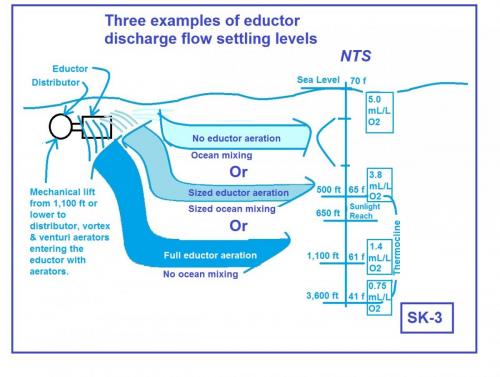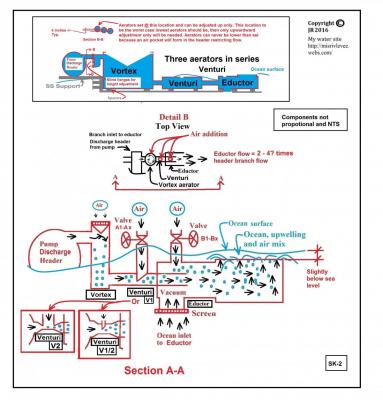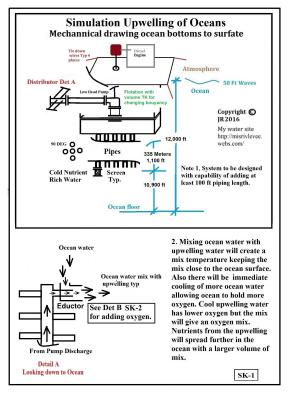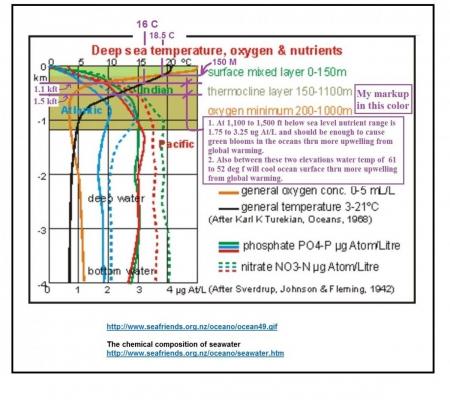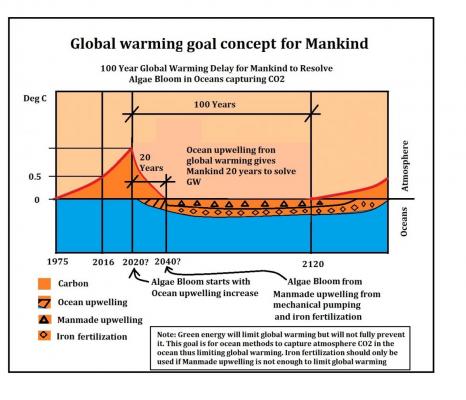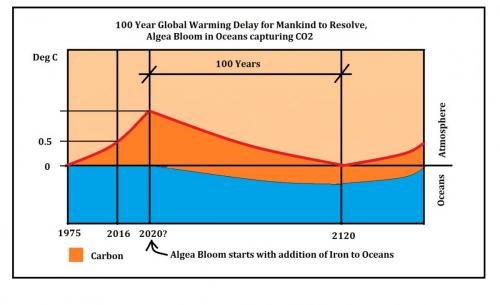

Ken123
Members-
Posts
29 -
Joined
-
Last visited
Content Type
Profiles
Forums
Events
Everything posted by Ken123
-

Iron in ocean to grow Plankton and capture CO2 in the atmosphere:
Ken123 replied to Ken123's topic in Earth Science
Kind of ran with your idea and may have found a way of aerating the mechanical upwelling water. Any thoughts would be greatly appreciated. Please see pictures below. One example: O2 for oceans at different depths. The system will have 6 eductors and 3 eductors on one side can be set for discharge to sunlight reach depth and 3 on the other side can be set for settling in the thermocline. Note, to settle at the thermocline the eductor has to have full aeration so there is no ocean water mixing and water temperature will be close to thermocline water temperature of 1,100 ft */-. Abstract Global warming can be reduced by plankton growth, which provides a sizeable contribution to decreasing atmosphere temperatures. Plankton growth comes by four means, natural ocean upwelling of nutrient-rich ocean water (A process in which deep, cold water rises toward the surface), increased ocean upwelling from global warming, mechanical simulation of waters upwelling from the ocean depth and if necessary, limited iron fertilization for reducing global warming. Reducing global warming by a concept of mechanical simulation of ocean upwelling is described in this book. By lifting ocean water from 1,100 feet below sea level to the ocean surface a plankton bloom will be formed. Flow from the mechanical lift will have oxygen added thru vortex aeration, ventures and eductors with the eductors mixing upwelling water with ocean water and air, then discharging at 100 KGPM or about 500 square miles per year at a depth of 6 Inches. One method of mixing will discharge at 66 f and settle 500 ft below sea level with same ocean water properties or higher because heating from surrounding waters . Sunlight travels 650 ft deep and plankton can grow at this depth. A 500 HP pump (Size of a large truck engine) is needed to do this and please see attached sketches. This concept will provide plankton blooms by way of nutrients and oxygen-rich (Because of aeration) cold waters mixed with the ocean, thus sequestering CO2 from the atmosphere and reducing global warming. If the system could be installed on oil platforms, cost will be reduced. And If interested in demonstrating this concept by lab simulation or other means, please contact me at pfsfst@cox.net or at my website. Eductor operation Eductor vacuum will change as a function of aeration flow change and this changing vacuum regulates eductor input water flow. For full aeration flow, input water flow to the eductor is 0 GPM and for no aeration flow, input water flow is maximum. Three examples: · For the sized eductor/aeration flow with motive water flow scaled to 1 and input water flow scaled to 1 (See 2. below). · For no aeration flow, input water flow is greater than 1 (See 1. below). · For full aeration flow, input water flow is 0 GPM (See 3. below). 1. For no eductor aeration flow and motive water flow of 1, input water flow is greater than 1. Eductor discharge temperature will be greater than 18.5 C (About 65 f) and will settle above 150 M depth (About 500 ft). Sunlight travels 200 M (656 ft) deep and plankton can grow at this depth. 2. For the sized eductor/aeration flow with motive water flow of 1 and input water flow of 1, eductor discharge temperature will be 18.5 C (About 65 f) and flow will settle at 150 M depth (500 ft). Sunlight travels 200 M (650 ft) deep and plankton can grow at this depth. 3. For eductor full aeration flow and motive water flow of 1, input water flow is 0 GPM. Eductor discharge temperature will be 16 C (About 61 f) and will settle at 335 M depth (About 1,100 ft). Sunlight travels 200 M (650 ft) deep and plankton cannot grow at this depth. -

Iron in ocean to grow Plankton and capture CO2 in the atmosphere:
Ken123 replied to Ken123's topic in Earth Science
Update to global warming concept goal drawing Competition between global warming Earth's energy ...A collapse of the Atlantic Meridional Overturning Circulation (AMOC) leads to global cooling through fast feedbacks that selectively amplify the response in the Northern Hemisphere (NH). How such cooling competes with global warming has long been a topic for speculation, but was never addressed using a climate model. Here it is shown that global cooling due to a collapsing AMOC obliterates global warming for a period of 15–20 years... Some indications of freshwater effects. ...One of the characteristics of the AMOC shutdown is a TOA radiation anomaly associated with increased ocean heat uptake24,25,26. In coupled climate models a shutdown of the AMOC is artificially forced by releasing large amounts of freshwater in the North Atlantic27, motivated by the fact that climate models cannot yet correctly simulate past abrupt climate change including an AMOC collapse28, affecting the likelihood of simulating future abrupt climate change29,30. None of the previous freshwater hosing experiments investigated the competition between a complete, permanent AMOC collapse, and greenhouse gases forcing acting simultaneously. In one case the AMOC was collapsed during a transient greenhouse scenario run by applying a sudden large freshwater pulse over just one time-step31, after which the AMOC recovered from its collapse, leading to a different interplay between radiative forcing and ocean dynamics from what is discussed here. Here, the impact of an AMOC collapse is analysed from an experiment in which persistent hosing, forcing the AMOC to remain in a collapsed state, is combined with increasing CO2 forcing, focusing on how they modify the ocean heat uptake and TOA radiation imbalances, and how these anomalies translate into different surface warming signals... Competition between global warming and an abrupt collapse of the AMOC in Earth’s energy imbalance Published online: 06 October 2015 http://www.nature.com/articles/srep14877 -

Ocean limited upwelling considerations for global warming
Ken123 replied to Ken123's topic in Earth Science
I may have posted incorrectly. Looked up blog definition and my post need to be in a blog. Will take time to see what post should be published on the forum. -

Ocean limited upwelling considerations for global warming
Ken123 replied to Ken123's topic in Earth Science
Competition between global warming Earth's energy ...A collapse of the Atlantic Meridional Overturning Circulation (AMOC) leads to global cooling through fast feedbacks that selectively amplify the response in the Northern Hemisphere (NH). How such cooling competes with global warming has long been a topic for speculation, but was never addressed using a climate model. Here it is shown that global cooling due to a collapsing AMOC obliterates global warming for a period of 15–20 years... Competition between global warming and an abrupt collapse of the AMOC in Earth’s energy imbalance Published online: 06 October 2015 http://www.nature.com/articles/srep14877 -

Ocean limited upwelling considerations for global warming
Ken123 replied to Ken123's topic in Earth Science
Seems like there will be more upwelling from global warming. Three articles about ocean upwelling in conflict. Article 1 shows more upwelling from global warming but article 2, I posted a few days, shows less upwelling. The article 2 link worked then but does not work now. Found the article by searching a phrase in the article and is a dead link. The #1 type information may have brought about the #2 article being closed. Article 1 reference is 2015 but did not get article 2 date because of the dead link. Article 3 2015 backs up article 1 in terms of global warming will increase upwelling. Article 1 ...Ecosystem productivity in coastal ocean upwelling systems is threatened by climate change. Increases in spring and summer upwelling intensity, and associated increases in the rate of offshore advection, are expected. While this could counter effects of habitat warming, it could also lead to more frequent hypoxic events and lower densities of suitable-sized food particles for fish larvae. With upwelling intensification, ocean acidity will rise, affecting organisms with carbonate structures. Regardless of changes in upwelling, near-surface stratification, turbulent diffusion rates, source water origins, and perhaps thermocline depths associated with large-scale climate episodes (ENSO) maybe affected. Major impacts on pelagic fish resources appear unlikely unless couples with overfishing, although changes toward more subtropical community composition are likely. Marine mammals and seabirds that are tied to sparsely distributed nesting or resting grounds could experience difficulties in obtaining prey resources, or adaptively respond by moving to more favorable biogeographic provinces... Anticipated Effects of Climate Change on Coastal Upwelling Ecosystems http://link.springer.com/article/10.1007/s40641-015-0008-4 Current Climate Change Reports June 2015, Volume 1, Issue 2, pp 85–93 Article 2 Upwelling and trade winds < Batture > 2016-12-30 16:54 ..How will global warming affect upwelling and coastal productivity? The strong dependency of upwelling processes on the strength of trade winds contains one hint. Remember that trade winds are zonal winds, which feed off the latitudinal temperature gradient. As this gradient weakens (high latitudes being warmed more than low, in all computer simulations), zonal flow will weaken. Monsoons, as we have seen, would be favored over trades. Thus, the upwelling that derives its energy from trade winds will weaken. Indeed, off California, upwelling of cold water has become less common since 1975, and the productivity of the California Current has diminished accordingly. A comparison of phytoplankton concentration during upwelling periods off the coast of Peru: (A) 1983, a severe El Niño and (B) 1985, a non-El Niño period. Note how much smaller the bloom (circled) is during El Niño conditions, when nutrient upwelling ceases. The color key needed to read the phytoplankton concentrations is the same as that in the above satellite image. (From: NASA) A similar decrease in productivity may be expected elsewhere in the eastern boundary currents, and in the eastern equatorial high production regions. Upwelling that depends on monsoon activity (as in the Arabian Sea) should be much less effected, or even benefit from the change.... Upwelling and Climate http://earthguide.ucsd.edu/virtualmuseum/climatechange1/11_2.shtml Article 3, 2015 Global warming to increase ocean upwelling, but fisheries impact uncertain http://oregonstate.edu/ua/ncs/archives/2015/feb/global-warming-increase-ocean-upwelling-fisheries-impact-uncertain -
knowing global warming is limiting ocean upwelling thus plankton blooms, how much upwelling has been limited in the past and more important how much this limited upwelling has contributed to limited plankton blooms thus contributed to global warming? If limited upwelling has great impact to global warming then considerations for mechanically drawing ocean water bottoms to the top should be actively explored. There is about 10% CO2 removal from the atmosphere by way of new plankton blooms from iron fertilization but may have higher atmosphere CO2 affect because of the upwelling concern. One year carbon tax pays for 10 ocean bottoms pumping systems magnitude cost $2 Billion(TBD). A carbon tax of $2.2 Billion /Yr = 180 MM tones of LPG Global Carbon produced /Yr Picture of mechanical oceans bottoms uplift System concept: http://i66.tinypic.com/idt25x.jpg Carbon tax: Picture of carbon tax http://i68.tinypic.com/2vlrwx2.jpg http://carbonsolutio.../Calculator.php LPG produced per year: Picture of LPG produced per year http://i63.tinypic.com/2llzwbs.jpg http://www.poten.com...ts-Jan-2016.pdf Reference pictures, calculations and pump information. AXIAL FLOW PUMP and line drop: Picture of flow curve http://i65.tinypic.com/nz3jts.jpg http://www.ensival-moret.com/-products-CAHRM-CAHRK-?lang=en Pressure Drop Online-Calculator Picture of calculation http://i66.tinypic.com/5ed36o.jpg http://www.pressure-...ine-Calculator/ Picture of KE calculation http://i63.tinypic.com/2n1do54.jpg
-
On a different Thread I shared a possible solution: http://www.scienceforums.net/topic/101950-iron-in-ocean-to-grow-plankton-and-capture-co2-in-the-atmosphere/ Posted Today, 07:12 PM Ken123, on 30 Dec 2016 - 6:45 PM, said: Picture of mechanical oceans bottoms uplift System concept: http://i66.tinypic.com/idt25x.jpg One year carbon tax pays for 10 ocean bottoms pumping systems magnitude cost $2 Billion(TBD). A carbon tax of $2.2 Billion /Yr = 180 MM tones of LPG Global Carbon produced /Yr Carbon tax: Picture of carbon tax http://i68.tinypic.com/2vlrwx2.jpg http://carbonsolutio.../Calculator.php LPG produced per year: Picture of LPG produced per year http://i63.tinypic.com/2llzwbs.jpg http://www.poten.com...ts-Jan-2016.pdf Ken123, on 31 Dec 2016 - 12:54 PM, said: AXIAL FLOW PUMP and line drop: Picture of flow curve http://i65.tinypic.com/nz3jts.jpg http://www.ensival-moret.com/-products-CAHRM-CAHRK-?lang=en Pressure Drop Online-Calculator Picture of calculation http://i66.tinypic.com/5ed36o.jpg http://www.pressure-...ine-Calculator/ Picture of KE calculation http://i63.tinypic.com/2n1do54.jpg
-

Iron in ocean to grow Plankton and capture CO2 in the atmosphere:
Ken123 replied to Ken123's topic in Earth Science
Picture of mechanical oceans bottoms uplift System concept: http://i66.tinypic.com/idt25x.jpg One year carbon tax pays for 10 ocean bottoms pumping systems magnitude cost $2 Billion(TBD). A carbon tax of $2.2 Billion /Yr = 180 MM tones of LPG Global Carbon produced /Yr Carbon tax: Picture of carbon tax http://i68.tinypic.com/2vlrwx2.jpg http://carbonsolutions.com/Calculator.php LPG produced per year: Picture of LPG produced per year http://i63.tinypic.com/2llzwbs.jpg http://www.poten.com/wp-content/uploads/2016/02/LPG-in-World-Markets-Jan-2016.pdf AXIAL FLOW PUMP and line drop: Picture of flow curve http://i65.tinypic.com/nz3jts.jpg http://www.ensival-moret.com/-products-CAHRM-CAHRK-?lang=en Pressure Drop Online-Calculator Picture of calculation http://i66.tinypic.com/5ed36o.jpg http://www.pressure-drop.com/Online-Calculator/ Picture of KE calculation http://i63.tinypic.com/2n1do54.jpg -

Iron in ocean to grow Plankton and capture CO2 in the atmosphere:
Ken123 replied to Ken123's topic in Earth Science
knowing global warming is limiting ocean upwelling thus plankton blooms, how much upwelling has been limited in the past and more important how much this limited upwelling has contributed to limited plankton blooms thus contributed to global warming? If limited upwelling has great impact to global warming then considerations for mechanically drawing ocean water bottoms to the top should be actively explored. I remember reviewing about 10% CO2 removal from the atmosphere by way of new plankton blooms from iron fertilization but there may be a higher atmosphere CO2 affect because of the upwelling concern. I will try to see if there are any articles on this. -

Iron in ocean to grow Plankton and capture CO2 in the atmosphere:
Ken123 replied to Ken123's topic in Earth Science
Thanks, greatly appreciated. -

Iron in ocean to grow Plankton and capture CO2 in the atmosphere:
Ken123 replied to Ken123's topic in Earth Science
Looked at the links but could not find "These thermoclines block the natural upwelling of nutrient-laden cooler water from the bottom to the surface". Also looking for how the blocks happen. Please check. Thanks -

Iron in ocean to grow Plankton and capture CO2 in the atmosphere:
Ken123 replied to Ken123's topic in Earth Science
Thanks, I made a preliminary matrix of concerns and resolutions for iron fertilization. Will need to adjust as I learn. I have studied articles on each item and the resolutions are shown in the articles. If anyone is interested in an item please request and will send the excerpt and link.associated with the item. Grow plankton with iron to reverse global warming Number Concern Resolution Reference 1 Red Tide Red tides have not been known to happen in open oceans where iron fertilization was executed 2 Dead zones Dead zones have not been known to happen in open oceans where iron fertilization was executed 3 More Carbon in the oceans Acceptable for 100 years because CO2 will be less in the atmosphere 4 Carbon not on ocean floor Not a concern because carbon will be in the water column 5 Carbon in water column Acceptable because less carbon in the atmosphere 6 Carbon acidify oceans Iron fertilization w/ green bloom captures CO2 from the atmosphere minimizing CO2 captured by the oceans with less acidification of oceans 7 Oceans do not remove CO2Incorrect because air-water interface are equilibrated 8 Globe is presently too hot Almost immediate action for iron fertilization of oceans is needed to quickly remove CO2 from the atmosphere and the globe will cool 9 Fillings are steel and not pure iron Use pure iron fillings for the fertilization 10 Ice melting Cooling the globe with iron fertilization cools ice, generates less active storms, less rain and 11 More active storms sea level not rising 12 More rain 13 Sea level rise Matrix Global Warming.doc -

Iron in ocean to grow Plankton and capture CO2 in the atmosphere:
Ken123 replied to Ken123's topic in Earth Science
Thanks for the insight. Will review. -

Iron in ocean to grow Plankton and capture CO2 in the atmosphere:
Ken123 replied to Ken123's topic in Earth Science
Farm the Oceans to Help Stop Global Warming It’s a controversial idea—but it’s already happening anyway. By David Biello 2016-12-24 00:34 http://www.slate.com/articles/technology/future_tense/2016/11/how_dumping_iron_in_the -

Iron in ocean to grow Plankton and capture CO2 in the atmosphere:
Ken123 replied to Ken123's topic in Earth Science
Global Warming delayed for Mankind to resolve. Oceans capture CO2 from the atmosphere for 100 years by adding Iron to the oceans generating algae blooms with CO2 levels decreasing in the waters. The ocean waters strip CO2 from the atmosphere as the ocean algae increase. After 100 years carbon is released back to the atmosphere by sea life exhaling CO2. Concept sketch -

Iron in ocean to grow Plankton and capture CO2 in the atmosphere:
Ken123 replied to Ken123's topic in Earth Science
But also Plankton is making using CO2 and releasing O2. Some of the carbon they eat becomes protein ...etc. and some is exhaled as you show. The protein is a result of the carbon from CO2 made by Plankton and the amount of CO2 removed from the environment is locked in the sea life proteins...etc. 2 indicators for iron dumping: 1. ...Iron Helps Prevent Formation Of Coastal Dead Zones... 2. ...Much of the carbon algae take up remains near the surface for hundreds of years... but carbon is not a problem the molecule CO2 is the problem Iron Helps Prevent Formation Of Coastal Dead Zones ...The German-American study team found that in high-oxygen conditions, almost all of the iron dissolved within the water precipitates – changing into rust-like iron oxide particles, which fall to the seafloor. The remains of dead plants and animals also sink to the seafloor and their rotting remains also use up oxygen dissolved in seawater. As oxygen decreases, a hypoxic dead zone may develop. If this takes place, iron oxides break down and may enter back into the water column where the iron becomes available to fertilize oxygen-generating plankton, the study researchers said. "When this moderate hypoxic state occurs, the iron release fuels more biological productivity and the organic particles fall to the sea floor where they decay and consume more oxygen, making hypoxia worse," said study author Florian Scholz, a postdoctoral earth sciences researcher at Oregon State University. "That leads to this feedback loop of more iron release triggering more productivity, triggering more iron release.” "But we found that when the oxygen approaches zero a new group of minerals, iron sulfides, are formed," Scholz added. "This is the key to the limit switch because when the iron gets locked up in sulfides, it is no longer dissolved and thus not available to the plankton. The runaway hypoxia stops and the hypoxic region is limited."... Iron Helps Prevent Formation Of Coastal Dead Zones http://www.redorbit.com/news/science/1113149570/dead-zone-cutoff-switch-iron-051914/ Seeding iron in the Pacific may not pull carbon from air as thought ...The most recent experiments have sparked protests from environmental groups. Some scientists say iron dumping could alter marine ecosystems in unpredictable and possibly harmful ways. Another problem: for excess carbon to be truly locked away, it must sink to the seafloor when the algae die. Some studies have suggested that while algae may grow quickly when fertilized, much of the carbon they take up remains near the surface for hundreds of years, cycling through other marine creatures, or bleeding directly back into the air. Phoebe Lam, an oceanographer at the University of California, Santa Cruz, who studies marine cycling of iron and carbon, said the paper "shows there are downstream consequences to anything you do in the ocean. It's what the geoengineers don't necessarily think of. It makes the idea of artificial iron fertilization require a discussion of much more subtlety." Sylvain Pichat, a marine geochemist at the University of Lyon, said the study "indeed shows that we need to think about the oceans and the climate system as a whole." Earlier this month, British researchers published a study showing how much still remains to be discovered: they observed that big icebergs increasingly calving off Antarctica are releasing vast trails of iron as they melt, triggering algae blooms for hundreds of miles—a possible mechanism that one could speculate might eventually push back against the manmade forces implicated in the calving.... Seeding iron in the Pacific may not pull carbon from air as thought http://phys.org/news/2016-03-seeding-iron-pacific-carbon-air.html -
The latest seems to show carbon will stay in the water column and sea life with eventually going back to the atmosphere and as far as I know this is a scientifically proven result. Are there any other scientifically proven results that are concerns? If it takes 100s of years for carbon to return to the atmosphere it may be worth doing because Mankind will have this time to try to solve CO2 concern in the atmosphere?
-
It May Be Too Late to Stop Global Warming http://abcnews.go.com/Technology/late-stop-global-warming/story?id=17557814
-
Wetlands Law has allowed trees to grow in the Amite Basin for more than 30 years and brought a $2 billion disaster to our country. Graph shows: If tree diameter growth is 0.5 inches per year for 30 years and the basin width is 4,000 ft, then tree area has increased 325 ft in the basin for 1.5 tree/ 20 ft of basin width or 500 ft for 2 trees/ 20ft. This growth has greatly restricted flood drainage in the basin and will generate more floods in Baton Rouge as the trees grow in diameter. Removing and selling enough trees to eliminate this increase will help flood drainage and there will be no extra erosion as compared to tree area 30 years ago. Anything I missed or incorrect?
-
The circumstances were mostly an air flow from the Gulf of Mexico with moist air but I do not know the exact reason for the high rainfall. This was an 500 year flood event. Yes, it is a regional concern. Please see basin map link. https://la.water.usgs.gov/images/AmiteBasinFloodMap.gif Solution C is being used with a diversion canal below the Amite River but the flood was much greater than the diversion. Solution B seems like what I am suggesting with removing tree area back to same tree area 30 years ago. Because of wetlands laws the trees have not been logged in 30+ Years. Will send this concept to the professor.
-
Most from north of Baton Rouge and south Mississippi. USGS flow was at 52 KCFS but river natural levee was topped and flow could have been greater than 80K CFS?
-
Flood size threat is growing by the year. For the Amite River basin tree diameter is growing yearly and I need to review further. If the trees doubled in diameter in the last 10 years then resistance of the basin has doubled or more preventing flood waters from draining as quick as needed. The next 10 years would bring a doubling of tree resistance again and Baton Rouge flooding will become more frequent and greater crest heights will be realized. Will review tree diameter growth and share more. Concept example: Also please see below USGS graphs showing 40 hours for the flood crest to travel from Port Vincent to Maurepas. The resistances to water flow is air, land, and trees and trees is the only variable that can be changed. Removing trees to have a tree area similar to 10 years ago would help drainage greatly because of less tree area in the basin than present and there will be no added erosion than was 10 years ago. Below picture of river levels are at Port Vincent, French Sediment and near Maurepas. This shows a spillway "only" may not help drainage and select removal of trees will be needed. It took about 40 hours for the crest to arrive at Maurepas from Port Vincent, April 15, 0:20 to April 17, 0:12 traveling 115K ft is 0.8 ft/s Please see below two replies with graphs. Ken Please see two replies with USGS graphs. Please see two recent replies with USGS graphs.
-
Please see updated sk and wording. Essentially list with whole basin 10-20 % select cut trees and the velocities will be less. Nine (9) locations with trees along the South Amite River, without roads, can be select cut (10 - 20%) for a 5,000+ Ft wide path. When the river is overflowing its banks there will be a wide path for flood waters to travel. Flow will stay in the river banks during low floods but for high floods over the banks, this path will quickly flow flood waters to Lake Maurepas. A hydraulics review needs to determine if a channel will be cut and if so what will be the effects on the river. In short the river will achieve drop per foot before a flood by flowing along its winding banks with land build up at channel intersections. Please see below video where steam channelization simulation was done and it returned back to its winding path. Note: Video has the meander stream completely blocked but the South Amite River may be slightly blocked and if(?) a shallow channel is cut then after a flood the river meander should not be cut off thus giving way for quick recovery of the meander to the same location with drop per foot as before a flood. The sketch should prevent a premature meander cutoff because the entire basin has an even distribution of trees removed. When a meander cutoff happens it will be a natural cutoff and acceptable. Stream Simulation Tables BYU Stream Table REF: Emriver channelization, large meanders, packed sediment Emriver channelization, large meanders, packed sediment ...This is a time-lapsed Emriver channelization demonstration in which a meander loop is cut off. In this case the channel length between two points is more than halved, so slope would increase by a factor of 2+..
-
No, I have not read it but looked at a review of the book and seems very interesting. Lately I have been working with Mississippi River Morphology and diversions. Found a concern and sent my calculations to the CORPS and they did not respond. Then Sent to a private university and the professor does the calcs for the corps. He agreed with me and below is a summary. Wetlands Restoration Engineers have not considered Mississippi River hydraulics for a future possible diversion, the Third Delta Conveyance Channel and I have performed necessary calculation showing a grave concern with the diversion and reviewed results with University discussions. Also a west Third Delta conveyance channel may be considered because of a need for depositing sediment west of Bayou Lafourche. Please Contact Coastal Protection and Restoration Authority (CPRA) asking about this concern. Third Delta Diversion will result in an unstable Mississippi River because river slope will increase when the diversion is added and this increased slope will add levee undercutting capability. The First Law of Thermodynamics (Conservation of Energy) was applied for calculating Mississippi River power associated with the diversion. USGS river discharge/stages were used for the calculations giving sobering results and our Government is listing this diversion in recent publications. The Concern: When the diversion is operated a large increase in Mississippi River power upstream of the diversion will be generated increasing scouring of river peak meander points causing levee failures. Calculations are performed associated with the Mississippi River/Third Delta Diversion location based on height of river change when the diversion added. One third (1/3) river flow will be diverted and 2/3 will continue in the normal channel. Height associated with river flow minus historical river height associated with 2/3 river flow is height change with the diversion addition. This height change causes a need for river length to increase upstream of diversion and generates large power increases upstream of the diversion. River length increase River slope post-addition of the diversion is 0.223 feet/mile. When the diversion is added river length upstream of the diversion would need to increase 34 miles to keep this slope and is based on river draw down (Height drop) of 8 feet when the diversion is added (8 feet/(0.223 feet/mile) = 34 miles). I want to mention I sent my flood drainage concept to a professor of civil engineering and he said the erosion would be a concern. Seems like the professor may have read my statement too fast and did not understand it giving a reply that is not based on my statement. The confusion of basin and channel seems very unclear. The statement and reply: My statement: Two solutions for flooding near Baton Rouge, La. are to remove trees restricting flow in the Lower Amite River Basin and remove man-made HW 22 flow restriction which is located on the basin's outlet thus increasing basin's velocity. Select, remove and sell trees in the basin from the river's mouth to north Baton Rouge and this will reduce flood crests with flow moving quickly along the 36+ mile basin. Because this is a public flood drainage concept hopefully tree removal would not need to meet wetlands mitigation cost. Water elevation will not build at an existing 5 ft high earthen HW 22 restriction because it will be removed and replaced with a HW 22-0.5 mile long elevated open bottom highway allowing flood water to flow underneath quickly releasing into Lake Maurepas. Reply: River systems do not work in a way similar to pipes. So, cutting trees would not necessarily lead to the reduction of channel roughness. The removal of trees would cause more channel bank erosion, resulting wider, shallower, or more sinuous channels. Therefore, channel roughness would not necessarily decrease following the removal of trees. 3. My overall conclusion about your concepts is that they would not work in the way you envisioned. FYI, I have added to my statement for detail clarity:Select removal of trees (10-20% ?) in the forested area of the basin between the river meanders but not along the river banks will minimize erosion because most trees will remain and major floods are few.

